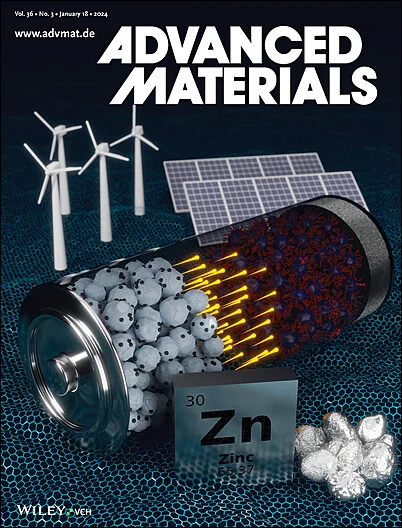对耐用锂硫电池的锂阳极多硫化物腐蚀现象的解读。
IF 26.8
1区 材料科学
Q1 CHEMISTRY, MULTIDISCIPLINARY
引用次数: 0
摘要
锂硫电池(li -硫电池)具有2600 Wh kg-1的超高理论能量密度,有望成为下一代储能系统。然而,可溶性多硫化锂(LiPSs)会严重腐蚀锂金属阳极,导致锂硫电池容量衰减快,循环寿命短。本文系统地研究了不同种类的LiPS对锂金属阳极的腐蚀。Li2S8和Li2S6对锂金属阳极的腐蚀速率高于Li2S4。腐蚀速率的差异主要是由于LiPSs与Li金属之间的持续反应,而LiPSs产生的固体电解质界面相很难阻止腐蚀。与Li2S8和Li2S6电解质相比,Li2S4电解质的锂核尺寸更小,锂沉积更均匀,锂金属阳极循环更持久。因此,提出了一种选择性抑制高阶LiPS腐蚀的LiPS选择策略,并成功地将Li-S电池的累积容量延长了31%。本研究阐明了不同种类的LiPS对锂金属阳极腐蚀的基本原理,强调了合理选择有利的LiPS种类以促进锂硫电池的循环耐久性。本文章由计算机程序翻译,如有差异,请以英文原文为准。
Deciphering the Species-Dependent Polysulfide Corrosion on Lithium Anode Toward Durable Lithium-Sulfur Batteries.
Lithium-sulfur (Li-S) batteries are promising next-generation energy storage systems due to their ultrahigh theoretical energy density of 2600 Wh kg-1. However, soluble lithium polysulfides (LiPSs) violently corrode Li metal anodes, inducing rapid capacity decay and poor cycling lifespan of Li-S batteries. Herein, the corrosion of different LiPS species on the Li metal anode is systematically investigated. The corrosion rate of Li metal anode by Li2S8 and Li2S6 is higher than Li2S4. The discrepancy in corrosion rate is attributed to the continuous reaction between the LiPSs and Li metal, while the corrosion can hardly be prohibited by the LiPS-generated solid electrolyte interphase. Smaller Li nuclei size, more uniform Li deposition, and more durable cycling of Li metal anodes are found in Li2S4 electrolyte in comparison with Li2S8 and Li2S6 electrolytes. Consequently, a LiPS selection strategy is proposed to selectively inhibit the corrosion of high-order LiPSs and successfully prolong the cumulative capacity by 31% in Li-S batteries. This work clarifies the fundamentals of Li metal anode corrosion by different LiPS species and highlights the rational selection of favorable LiPS species for promoting the cycling durability of Li-S batteries.
求助全文
通过发布文献求助,成功后即可免费获取论文全文。
去求助
来源期刊

Advanced Materials
工程技术-材料科学:综合
CiteScore
43.00
自引率
4.10%
发文量
2182
审稿时长
2 months
期刊介绍:
Advanced Materials, one of the world's most prestigious journals and the foundation of the Advanced portfolio, is the home of choice for best-in-class materials science for more than 30 years. Following this fast-growing and interdisciplinary field, we are considering and publishing the most important discoveries on any and all materials from materials scientists, chemists, physicists, engineers as well as health and life scientists and bringing you the latest results and trends in modern materials-related research every week.
 求助内容:
求助内容: 应助结果提醒方式:
应助结果提醒方式:


